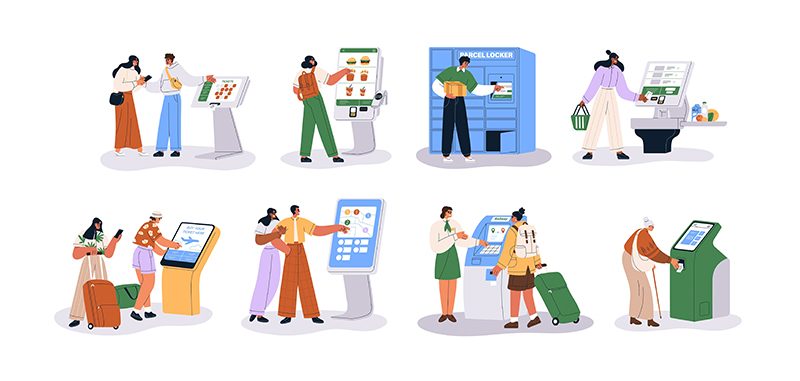Interactive Kiosks Uses For Each Industry

Interactive kiosks are free-standing structures that display wayfinding information and advertisements, let customers place orders, and interact with digital content. More businesses are adopting interactive kiosks to meet the increasing demand for self-service technology. As it stands, 66% of customers prefer interactive kiosks over interacting with staff.
Some interactive kiosks feature pre-installed content management software for commerce, communication, and personalized customer experiences. Further, your self-service kiosks can be customized with ADA compliance, multi-language support, VoIP capabilities, QR codes, Wi-Fi, and other technologies for maximum customer engagement.
Interactive Kiosks by Industry
Interactive kiosks have many uses and benefits, including tourism, wayfinding, bill payments, and ticketing. Check out how digital kiosks can be used in different industries below.
1. Banks
Despite the rise of online banking, many people still visit physical branches to open an account, apply for loans, and navigate complex transactions. As such, banks and other financial institutions must improve customer experience and access to financial products. Today’s customer expects convenient and swift services from all service providers, including banks and credit unions.
Self-service kiosks in banks allow customers to complete standard transactions and reduce their wait times. Usually, long queues frustrate consumers, create a negative brand image, and overwhelm employees. With a digital kiosk, a customer can open an account, transfer funds, scan documents, deposit checks and cash, and print receipts without staff assistance.
This level of convenience attracts more customers, increasing revenue and enhancing brand perception. Moreover, self-service kiosks decrease staff and operation costs.
Interactive kiosks also let visitors browse your product catalog, discovering new products they didn’t know you offered. So, broadcast videos on your auto loans, mortgage plans, credit cards, industrial loans, consultation services, and foreign exchange services to increase the bottom line.
2. Entertainment
Visitors in museums, amusement parks, exhibitions, trade shows, and other entertainment venues expect immersive and engaging experiences. Specifically, customers want seamless access to wayfinding, ticketing, and promotional information to make quick decisions.
Interactive kiosks streamline operations for entertainment venues in different ways. First, ticketing kiosks reduce waiting times at music concerts and live sports and encourage customers to visit gift shops and concession stands because they have extra time.

Second, digital directories on interactive kiosks help visitors navigate large venues. Simply, a customer can search for restrooms, restaurants, and playgrounds and receive personalized directions.
Interactive kiosks are excellent for event promotion because you can brand the booth and display. Then, show product demos, FAQs, and training videos during product launches. Further, integrate your logos, brand colors, and slogans into your digital content to drive brand recognition.
Lastly, self-service kiosks allow staff to focus on tasks that add value by handling mundane tasks like registration, ticketing, bill payment, and self-checkout. In fact, your business can free up as much as 69% of its time by automating data processing activities.
3. Hotels
Rising customer demands in the hotel industry are driving the fast adoption of self-service kiosk solutions. To start, an interactive touch-screen kiosk allows guests to check in and avoid long lines.
Advanced kiosk platforms accept payments and let guests browse through different rooms on virtual maps. Additionally, visitors can scan their identification documents and fill out paperwork without speaking to staff. Similarly, guests can check out just as quickly when leaving your facility, leading to high customer satisfaction rates.
An information kiosk is a must-have addition to your hotel lobby and hallway because it keeps guests aware of upcoming events, discounts, and loyalty programs. For instance, a guest can discover tourist attractions near your hotel and check for transportation options.
Your staff will also appreciate the presence of self-service kiosks because they won’t spend much time resolving complaints and doing manual tasks. Instead, your employees can focus on knowing your customers better and improving the guest experience.
4. Retail
Despite the boom of online shopping, people flock to physical stores because they can touch and feel products and buy them instantly. However, customers want memorable and personalized in-store experiences that stand out from the norm. Specifically, 57% of customers desire self-service, mobile checkout, virtual reality, and other technologies in retail stores.
Interactive kiosks have many use cases in retail stores. First, self-service kiosks display a comprehensive catalog of products and services to influence purchase decisions. Customers who want an out-of-stock item can preorder at the kiosk and choose a delivery method.
Multi-touch kiosks also attract attention, unlike static posters, and entice a customer’s sense of discovery. You can display product demos or empower customers to compare prices for different items.
Most importantly, interactive kiosks are an easy way to collect in-store data from consumers. For instance, monitor top-searched products and traffic patterns and modify your inventory and store layout accordingly. Moreover, deploy customer satisfaction surveys and loyalty programs to learn more about what your consumers want.
5. Restaurant/ QSR
Many restaurant chains, including McDonald’s, Panera Bread, and Taco Bell, have adopted self-service kiosks to reduce operation costs and streamline the customer experience. But, independent restaurants also have much to gain from deploying self-service kiosks.
A restaurant kiosk displays a digital menu, guiding customers as they build their orders and make payments. In addition, the display highlights promotions and upsells items to encourage impulse purchases.
By reducing wait times, digital kiosks boost revenues and widen the customer base. Indeed, 65% of customers report they are likely to visit a restaurant if it has self-service kiosks. What’s more, ticket sizes are 12% to 20% higher at self-service kiosks than at the cashier.
Typically, staff messes up customer orders, especially if they are overwhelmed by long lines. Interactive kiosks ensure order accuracy, reduce employee stress, and increase customer satisfaction. Ultimately, digital kiosks cater to customers’ needs without inflating operation expenses.
6. Healthcare
Interactive kiosks are transforming the healthcare industry by centralizing communication and empowering patients. Usually, patients and loved ones get confused navigating complex hospital facilities. Fortunately, wayfinding kiosks at entrances, hallways, and near elevators show interactive maps and directories to ease navigation.
Further, interactive kiosks serve as queue management stations where visitors can identify themselves and schedule appointments. Consequently, visitors spend less time waiting at counters, and employees are free to focus on more complex tasks.
Digital kiosks are excellent investments to speed up patient flow and care since they handle more patient processes than employees. In practice, patients quickly check in, make payments, print receipts, order prescription refills, and confirm eligibility for procedures without consulting staff.
Additionally, interactive kiosks eliminate cumbersome paperwork, which frustrates patients who need to see a medical professional right away. In the long run, self-service technology empowers you to provide high-quality medical care and increase customer satisfaction.
7. Education
Today’s students are increasingly dependent on technology in their daily lives. As such, your facility must adopt modern-day technologies to keep students informed and engaged.
Initially, schools used interactive kiosks for self-registration and ID printing to eliminate long queues. Over time, self-service kiosks have become versatile tools for education facilities to disseminate information and guide visitors.
For instance, students can explore timetables, examination updates, faculty changes, and project submission dates. Moreover, payment kiosks allow students to pay tuition, exam, and recreational fees and buy books using cash or cards. Other interactive kiosks have an internet browsing functionality that lets students learn more about a particular subject.
Most educational institutions have multiple events running at any given time, such as sports games, music events, theater programs, and social meetups. By integrating events apps into your kiosk software, you can easily update your students about upcoming events and highlight social media feeds to encourage them to sign up.
Transform Your Industry With Interactive Kiosks Today!
Interactive kiosks streamline operations across various industries, including sports, retail, financial services, healthcare, and corporate offices. These kiosks function as digital signage when not in use, meaning they can advertise new products and services, promote loyalty programs, and let customers know more about your company. Ultimately, interactive kiosks connect and engage visitors and enhance your brand image.


